Having launched EASy II and gained joint US Federal Aviation Administration and European Aviation Safety Agency certification for the digital avionics system on the Falcon 900LX, Dassault's flight test department is now busy with the Falcon 7X, the Falcon 2000LX and the Falcon 2000S. Joint certification of the system for each type is to be completed by year-end.
Dassault's objective is to see EASy II become the standard avionics fit across the complete new-build Falcon business jet family, starting from the beginning of next year. As a sign of progress, the 200th Falcon 7X on order - presently under construction in France - is being fitted with an EASy II cockpit ready for its 2013 delivery.
 |
|---|
© Dassault The 200th Falcon 7X on order, to be delivered next year, is being fitted with an EASy II cockpit |
Any Falcon jet equipped with EASy I can be upgraded to EASy II without technical difficulty - EASy II comes in "baseline" standard with a long list of options. But all of the new upgrades within EASy II come with the future built in - they will address the coming revolution in advanced air traffic management systems that will start to become mandated from 2013 and be fully implemented from 2015, over massive areas of airspace worldwide.
Other design goals for EASy II included improved situational awareness, flight safety and aircraft operational capabilities. Situational awareness improvements now start with the left and right primary flight displays supporting a synthetic vision system (SVS). This offers a real-world picture of terrain, airfield and land features based on the enhanced ground proximity warning system terrain database, overlaid by the head-down display (HDD) flight symbology.
PREVENTING SWIM
This HDD symbology now matches that shown on the head-up display (HUD), and the aircraft symbol is flight-path vectored (climb/dive/drift) but set within a flight-path ladder that is fixed to prevent velocity vector (VV) "swim" of the entire display - a problem with older full-VV displays.
This flight-path vector (FPV) design approach and the HDD now fully matching the HUD - rather than the other way around, as was the case in older HUD systems - is an industry-leading design feature. Other situational awareness improvements include the runway awareness and advisory system and XM Weather - which displays real-time actual weather charts (presently only covering the USA and Canada). Also included is an automatic descent mode to bring the aircraft down safely from a high-level depressurisation - the Falcon 7X is cleared to cruise at 51,000ft (15,500m) - and an enhanced electronic chart library that allows for a dual Jeppesen chart display and increased redundancy so that the aircraft can operate with a paperless cockpit. Additional electronic flightbags, fitted at each side console for each pilot, also continue to be a standard Falcon option.
Operational capabilities now include "satellite-based augmentation system - localiser performance with vertical" guidance (SBAS/LPV), to give an instrument landing system (ILS)-type of precision guidance down to a 200ft decision altitude, equalling a Cat I ILS - but to a non-equipped runway. More than 2,400 LPV approaches have been certificated in the USA, and the first are now being certificated in Europe. To support SBAS/LPV worldwide an entire range of new, augmented international satellite navigation systems are being used or planned, with WAAS in the USA, EGNOS in Europe, MSAS in Japan, GAGAN in India and SNAS in China.
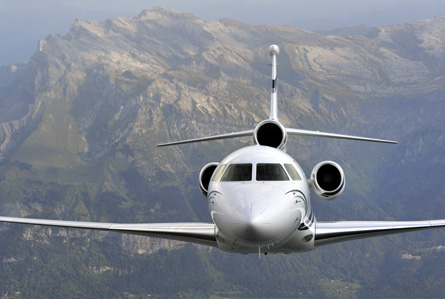 |
|---|
© Dassault Thanks to its 6,000nm range, the Falcon 7X is capable of direct flight from London City to New York, given still air-type conditions |
Additionally, EASy II supports "required navigation performance - authorisation required" guidance (RNP AR), both laterally and vertically, to allow specifically authorised crews to fly curved approaches, typically for noise or terrain constraints - again down to near Cat I ILS minima. The required navigation performance of EASy II is 0.3. Finally, the "take off and go around" (TOGA) mode now directs the aircraft vertically and laterally from the start of the take-off roll - either when the flight director is followed manually by the pilot or with autopilot and autothrottle coupling - through the entire take-off sector profiles, at the correct speeds - including in the event of an engine failure - up to the end of the fourth take-off sector.
LIGHTER WORKLOAD
Selecting TOGA on go-around now engages the flight management system's lateral navigation mode automatically.
All this adds up to a huge decrease in pilot workload and improved crew co-ordination at what is often one of the highest safety-critical events that a pilot has to cope with, since a take-off or unplanned go-around - especially near terrain or in busy airspace - needs very careful handling, and must be followed with just as much precision as that demanded by a published arrival and approach procedure.
Future ATM systems will revolutionise the way that aircraft are controlled. Older aircraft that are not suitably equipped will be faced with non-flexible routing or be excluded from large vertical sections within that airspace, much like the reduced vertical separation minima applied today. The first future ATM system is automatic dependent surveillance - broadcast (ADS-B) "out", where the aircraft automatically broadcasts its precise position and intent to air traffic control (ATC). The future follow-on to this will be ADS-B "in", where crews on board equipped aircraft will be able, in essence, to conduct their own airborne ATC with regard to separation and routings, once cleared to do so by ground ATC.
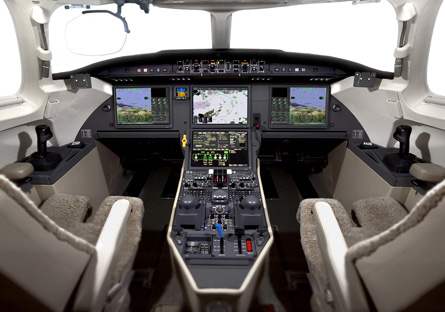 |
|---|
© Dassault The Falcon 7X also offers anew third-generation HUD, upporting the latest ehanced vision system |
Another future system is the "controller pilot datalink communications - aeronautical telecommunications network" (CPDLC-ATN), where pilot acceptance of flight plans and acknowledgment of ATC instructions will be carried out on screen in the cockpit rather than by radio. This need by the pilots to communicate with ATC on-screen is an important design driver towards the new generation of large-screen glass cockpits that EASy II represents. The European CPDLC-ATN is already in operation over the Netherlands and will be mandated across the whole of Europe from 2015. Any aircraft not equipped with CPDLC will be limited to flight level 285 (28,500ft/8,700m) or below.
The Future Air Navigation System (FANS1/A) is the CPDLC equivalent for Oceanic airspace. It offers lower crew workload, more flexibility in terms of crew requesting route or flight-level changes, and general flight safety over and above the old, rigidly procedural high-frequency radio reporting system. Some Oceanic tracks are now exclusive for FANS1/A-equipped aircraft, so non-equipped ones may be constrained to longer routes.
EASy II will feature a new version of the flight management system - FMS version 7.1 - which includes such features as automatic temperature compensation to the vertical navigation profile. This is critical for safety - and terrain clearance - at low outside air temperatures when flying LNAV/vertical glide path (VGP) and RNP AR-type approaches.
The Falcon 7X also offers a new third-generation HUD, supporting the latest enhanced vision system based on a forward-looking infrared sensor and nose-mounted camera.
Additionally, all Falcon business jets are steep-approach certificated - including London City airport, with a 5.5˚ approach path, and also Lugano, Switzerland, with a 6.7˚ approach path. The aircraft has to be shown to be safe and stable in testing during a number of approach "abuse cases", one of which is an approach path of +2.0˚. Therefore, Lugano certification requires flight testing to show compliance at an approach path of 8.7˚.
Passenger luxury in the new-build Falcon 7X has been enhanced with a new interior designed by BMW, a full walk-in shower compartment and an advanced cabin management system featuring Blu-ray DVD-based entertainment and in-flight internet connectivity.
In mid-March, Dassault gave Flight International the chance to evaluate EASy II avionics in a real aircraft. My evaluation aircraft was the Dassault flight test Falcon 7X, registered F-WFBW, and our plan was to fly two steep approaches - 5.5˚ approach path - and landings into London City airport, after a short practice and departure from the Dassault test centre at Istres, France.
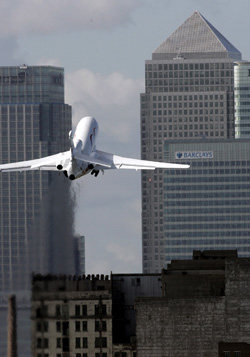 |
|---|
© Dassault London City makes steep demands |
It was an opportunity to see how the new avionics of the EASy II - especially features such as the SVS, the HUD, the FPV-based display and the steep-approach mode - combined with the fly-by-wire (FBW) of the Falcon 7X to decrease pilot workload while improving situational awareness and - as a consequence - flight safety. Having flown steep approaches into London City in the Fokker 70, the Fokker 50, the Hawker 800 and the Dornier 328, my objective was to try and quantify how much better this new aircraft package was for one of the most demanding approach profiles a commercial pilot will be expected to face.
In May 2007, I evaluated the handling characteristics of the Falcon 7X - then equipped with EASy I. In March 2011, I tested the new "third generation" HUD/enhanced vision system while flying night, low-level visual circuits at Chambery, in France. London City steep approach certification was gained for the Falcon 7X in 2008, and it remains the largest business jet capable of operating at the airport, while meeting its very strict noise requirements. The noise footprint of the Falcon 7X has been shown by Dassault to be at 90.1 perceived noise decibels (PNdB), which places it well below the upper limit for "level B" turboprop-type aircraft, set at 91.5PNdB - and puts it on a par with medium-sized turboprops such as the ATR-42 or Fokker 50. However, the Falcon 7X is still classed as a London City "level A" aircraft because it is a jet.
OPERATIONAL FLXIBILITY
With a basic operating weight of 36,500lb, a maximum landing weight at London City of 45,000lb and a maximum take-off weight at the airport of 57,000lb, the 6,000nm (11,100km) range of the Falcon 7X means that it can fly transcontinental routes and land at London City with ample fuel reserves to drop off passengers and fly out to park elsewhere. It can also take off from there with passengers and fly direct to New York, given still air-type conditions. No other business jet can match this level of operational flexibility.
My safety pilot for the evaluation was Philippe Deleume, Dassault's chief test pilot. in the right-hand seat. I would fly the complete evaluation from the left-hand seat.
We would fly two visual circuits at Istres - the first to practise the London City noise-abatement profile and the second the TOGA profile, including a simulated engine failure after take-off. Both circuits would finish with a simulated 5.5˚ approach and landing.
Given the aircraft's fly-by-wire technology, the pilot controls pitch or roll rate equivalent to his/her side-stick deflection - essentially independent of airspeed. Therefore, on the first take-off with the aircraft at 45,000lb, Slat/Flap 2 (SF2) at rotate and VR at 103kt (190km/h) indicated air speed, full-back side-stick was applied and held at the back stop to give a rotate rate of approximately 5˚/s.
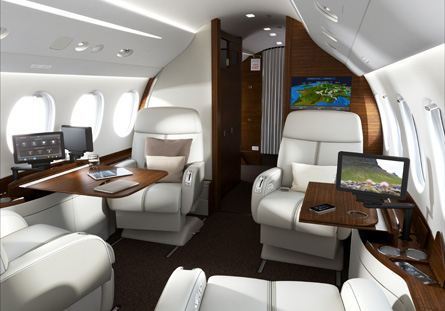 |
|---|
© Dassault The 7X's cabin offers a full shower suite and Blu-ray DVD-based entertainment, alongside a comfortable and quiet environment |
A small rising cue in the HUD - also replicated in the HDD primary flight display - was used as a pilot guide, when it approached the horizon line, to transfer attention to the FPV symbol to accurately capture the flight director symbol at a climb flight path angle allowing a minimum target speed of V2+20 or a maximum pitch angle of 20˚.
Gear retraction was called immediately, and at 300ft the pilot not flying (PNF) challenged the pilot flying (PF) for intention, so that at 400ft the PF - still with both engines - called for power reduction and the PNF manually reduced the power on both engines by -14% N1 to a pre-take-off calculated reduced N1 figure. Then, after reaching a take-off safety altitude of 1,100ft, the aircraft was flown in vertical path at an angle parallel to the standard instrument departure climb path requirement to level off at 3,000ft. The procedure was simple to fly, follow and crew co-ordinate.
The Easy II TOGA profile with engine failure was another joy to fly. With the FPV (outer circle) overlaying the flight director (inner smaller circle) and the aircraft automatically recognising that it had an engine failure, the flight director - manually followed in this case - led me through the complete take-off profile at the correct speeds for each sector. With LNAV coupled there was no "drift-off track" that can occur if HDG (basic heading) is selected by the pilot.
The new Falcon 7X HUD is good, clear and well behaved that I had no need or desire to go head down to the HDD primary flight display to check for additional information.
Both practice steep approaches at Istres were flown in the London City configuration of 5.5˚ path, Slat/Flap 3 (SF3), Airbrakes 1 (AB1), Vref+5 of 117kt (indicated air speed), and at around 44,500lb. Given day, visual flight rules (VFR) conditions, the enhanced vision system was not used, but both steep-approach practises were flown manually through the HUD. The first was flown with autothrottle engaged and the second with autothrottle off and manual thrust. The AB1 configuration - since it is in part an in-flight spoiler system - does generate a small amount of cockpit vibration as the disturbed airflow interacts with the horizontal stabiliser set mid-fin. Still, the aircraft felt rock steady in both approach angle and speed stability. Even with autothrottle off, tiny manual throttle movements would allow me to hold Vref steep to +/-1kt. At 70ft altimeter and just before the audio call out of "50 feet", the flare was started into an ultra-precise, soft touchdown. As angle of attack increases in the flare the airbrakes retract automatically - as they would in a TOGA situation - even though the airbrake lever remains at the AB1 position.
GOD'S EYE
On the flight across to London City I was able to evaluate the EASy II and SVS in more detail. The effect of the SVS is stunning and somewhat uncanny as, for instance, when you line up on a runway what you see head-down is what you see through the windscreen. Everything in the HDD primary flight display is now "day/VFR/good weather", and outside ground features match the HDD primary flight display SVS as you look at each of them in turn. The "God's eye" vertical navigation display is now complemented by the SVS 3D display in the HDD primary flight display - including the programmed approach path at the destination airfield. The EASy II's use of colour, FPV symbology, mode annunciation and split-screen division of information blocks gives the pilot an impression of being surrounded by information - but never overwhelmed by it, as it can be managed and interpreted easily.
EASy II with SVS is such a step-change in capability that this type of glass cockpit is now as far away from the earlier, small-screen electronic flight information system cockpit as the EFIS was from the old analogue cockpits.
The rate of progress in avionic displays defies belief. EASy II continues to have the best man-machine interface of any avionics system I have operated. The two steep approaches at London were non-events, since they were so easy to fly and land accurately.
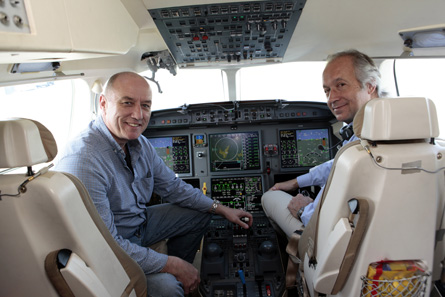 |
|---|
© Dassault Flightglobal test pilot Peter Collins (left) in the Dassault Falcon 7X EASy II cockpit |
I believe EASy II and the upgraded features it offers grant the aircraft it supports an almost total "safety sphere" around the hull, crew and passengers. Corporate flying on very long-range business jets can demand some unique challenges of the crew, but the EASy II represents the biggest single advance to flight safety - through its man-machine interface and situational awareness - that I have evaluated.
Some aircraft have "enhancing" features because of certain individual components of good design, but I believe the Falcon 7X that I tested - equipped with EASy II and the new-generation HUD /enhanced vision system - is as close to being a total "enhancing package" as anything I have come across.
I make this statement with reference to all the other large commercial and corporate aircraft types - some 35-plus - that I have flown or evaluated in my test-pilot career.
- What did Peter Collins make of Dassault's Falcon 2000S? Read his verdict
Source: Flight International























